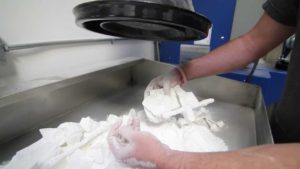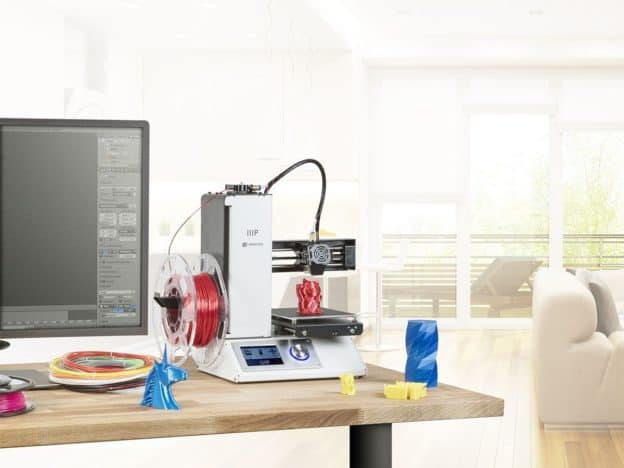There are nine major types of 3D printers worth knowing about if you are deeply interested in 3D printing, but as a hobbyist what do you really need to know? Your time is precious and I want to protect that.
3D printing encompasses such a wide variety of knowledge that we should probably narrow the focus … for now. Accordingly, I have selected the top three you should know about. These will come as no surprise to many. The three most talked about kinds of 3D printers are FFF/FDM, SLA, and SLS. If you are just wondering what kind of printer you should think about as a hobbyist I recommend focusing on FFF/FDM. This is by far the most widespread 3D printing format. It has the lowest price points and the biggest community which is key when you are getting started. If you’re still interested in learning more about the FFF/FDM, SLA and SLS printers I’m here for you. Let me highlight the big points for you below.
Fused Filament Fabrication (FFF)
We’ll start with the most accessible and most popular of the three. Fused Filament Fabrication (FFF). If you want to know why I refer to the process as FFF and not FDM check out this article about the difference between FFF and FDM.
FFF takes a filament, generally, PLA or ABS plastic then melts it and adds it in thin layers to create an object based on a 3D model. Some FFF printers can print other materials, but the vast majority you will come across do not. Machines that can print other materials come with price tags to match.
Interestingly, FFF printing gives objects a grain like wood because it builds in layers. The layering does mean that the objects printed are stronger in one direction than another. Imagine a pile of CDs stacked one on top of the other and glued together. If you push down on the pile you will have little effect. If you push sideways on the pile the cd’s hard enough they will slide or shift off of one another.
This technology began under the name FDM in the 1980s so the age and overall development give it an advantage. As a solid technology that can be reproduced in homes both cheaply and safely, FFF maintains a spot as king of the home market. FFF printers can run anywhere from $300 dollars at the low end all the way up to a high-end price of $3000 dollar machines.
Stereolithography (SLA)
Stereolithography (SLA) is fascinating. It uses a vat of photopolymer resin that reacts to light to create incredibly high-resolution prints. The process works by moving a build plate in very small increments exposing the resin to a UV laser that draws each layer. SLA models are taken out of the printer when completed and frequently placed in an ultraviolet oven in order to cure and harden it.
With SLA you are able to create incredibly smooth, high-resolution objects, but the resins currently come in limited colors. SLA is very fast by 3D printing standards and has some traction in industries looking for economical 3D printing. These printers generally run 3K and up, and as such are not likely to gain much traction in the home 3D printing community yet. Perhaps small businesses will pave the way?
Selective Laser Sintering (SLS)
Another technology created in the 1980s is Selective Laser Sintering. This system melts a powder together with a powerful laser. The way the machine works is very similar to the SLA printer, but rather than using a resin it uses a powder. Because these printers use a powder they require a much more powerful laser. The specialized laser rockets the price up into commercial territory.
SLS can make models out of metal but primarily uses plastic for its creations. Most interestingly SLS can fuse different colors together allowing a maker to create custom-color 3D prints.
The price of this commercial grade machine is prohibitive at 10k and up. Some hobbyists that are really interested can try building themselves an open source model found on the web. this model is called the pwdr printer. Of course, because this is still in very limited use the materials for printing remain expensive. The use cases for home use of this printer are not yet a strong enough incentive to shell out the dough for this one.
So Much More Out There
We already mentioned there are many other types of 3D printers. Why haven’t I discussed them? They just aren’t as important for a hobbyist, and that’s who I primarily write for. The three we covered, FFF/FDM, SLA, and SLA are the technologies you’ll see most as you surf the web. That being said the primary most feasible 3D printers on the market for hobbyists right now are FFF due to price and accessibility.
If you are interested in what I left out check out the list below:
- Digital Light Processing (DLP)
- Selective Laser Melting (SLM)
- Electronic Beam Melting (EBM)
- Laminated Object Manufacturing (LOM)
- Binder Jetting (BJ)
- Material Jetting (MJ)
They are pretty cool. 3D printing has a bright future.
Before You Go
You know about the types of printers and how they work on a theoretical level. Is it time to understand how they actually work? I have an article devoted to the anatomy of FFF 3D printers where I take an in-depth look at a Cartesian 3D printer’s parts. Not sure what a Cartesian printer is? Maybe you want to look at my article discussing four different styles of FFF/FDM 3D printers.

